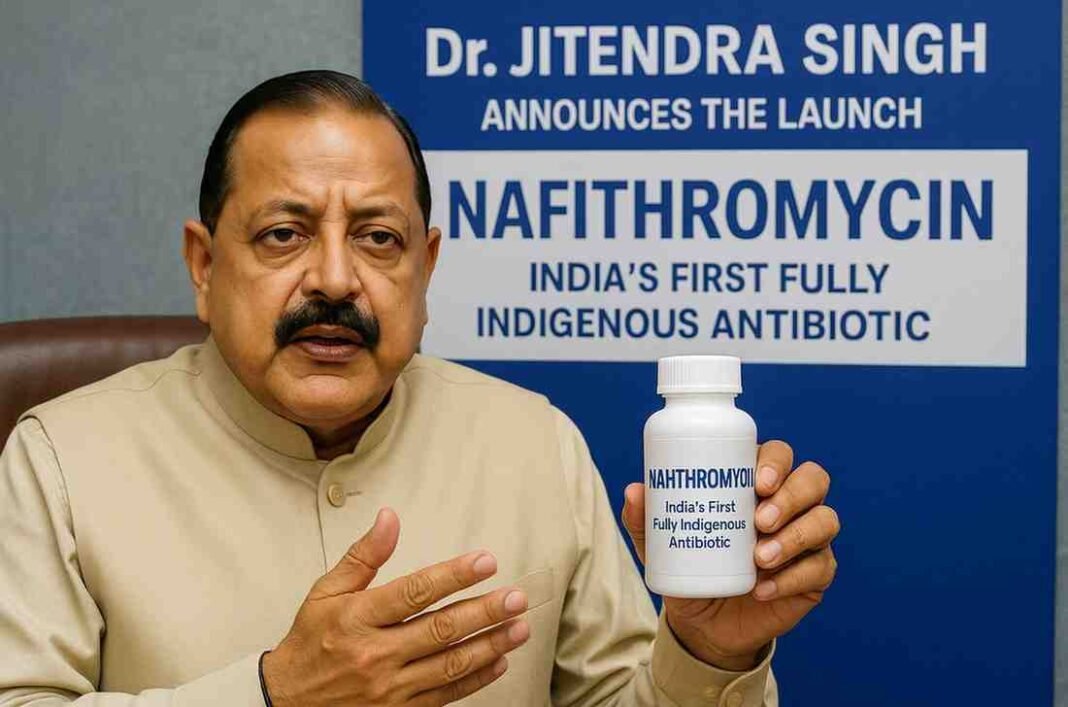
India Develops Its First Indigenous Antibiotic for Respiratory Infections
In a major stride towards self-reliance in advanced medical research and pharmaceuticals, India has introduced its first indigenously developed antibiotic, Nafithromycin. The discovery represents a historic milestone in the nation’s pursuit of scientific independence and innovation. Union Minister of State (Independent Charge) for Science and Technology, Dr. Jitendra Singh, made the announcement while inaugurating a three-day workshop on “Harnessing Artificial Intelligence for Multi-Omics Data Integration and Analysis.”
Dr. Singh stated that Nafithromycin is the first antibiotic molecule to be entirely conceptualised, developed, and clinically validated in India. It is particularly effective against resistant respiratory infections — a growing concern worldwide — and holds significant promise for patients with compromised immunity, such as those undergoing cancer treatment or managing poorly controlled diabetes.
Breakthrough in Indigenous Drug Discovery
The development of Nafithromycin marks a defining achievement for India’s pharmaceutical and biomedical research sectors. For decades, India has been known as the “pharmacy of the world,” primarily producing generic medicines. However, this is the first time a completely homegrown antibiotic molecule has successfully passed through all stages of research and clinical validation.
Dr. Singh underscored that the discovery symbolizes India’s emergence as a global hub for biomedical innovation. The antibiotic’s efficacy against resistant strains of bacteria highlights India’s growing capabilities in addressing global health challenges through indigenous research. The findings have also been published in the New England Journal of Medicine, one of the world’s most prestigious scientific journals, validating the breakthrough on an international platform.
Science and Technology Minister @DrJitendraSingh inaugurates a medical workshop in New Delhi.
He informs that India has developed its first indigenously discovered antibiotic Nafithromycin.
He says that this antibiotic is effective against resistant respiratory infections,… pic.twitter.com/ndRoyrhM5p
— All India Radio News (@airnewsalerts) October 18, 2025
A Leap Toward Self-Reliance in Biotechnology
Highlighting the government’s long-term vision, Dr. Singh said that India is steadily moving toward building a self-sustainable ecosystem for scientific growth. The Anusandhan National Research Foundation (ANRF) — with an ambitious budget of ₹50,000 crore over five years — aims to transform India’s research landscape by promoting innovation-driven collaborations between the public and private sectors.
Of the total funding, ₹36,000 crore is expected to come from non-governmental sources, reflecting the growing confidence of the private sector in India’s research potential. The minister emphasized that nations leading in science and technology have achieved global success through self-sustaining, innovation-based ecosystems, and India must follow the same trajectory.
India’s Advances in Genomics and Gene Therapy
Dr. Singh also revealed that India has successfully sequenced over 10,000 human genomes and plans to scale up this effort to one million in the near future. This monumental project will help India build a rich genetic database, crucial for personalized medicine, disease prediction, and precision healthcare.
In another groundbreaking development, India has recorded its first successful indigenous clinical trial in gene therapy for Hemophilia treatment. Supported by the Department of Biotechnology and conducted at the Christian Medical College, Vellore, the trial achieved a remarkable 60–70 percent correction rate with zero bleeding episodes. This represents a major leap in India’s ability to produce advanced medical therapies domestically.
AI Driving the Future of Healthcare Innovation
Addressing the growing integration of artificial intelligence in healthcare, Dr. Singh emphasized that AI has become one of the most transformative technologies of the modern era. It is reshaping healthcare delivery, improving accessibility, and enhancing governance efficiency.
Institutions such as Sir Ganga Ram Hospital have been at the forefront of adopting interdisciplinary models by combining AI, genomics, and biotechnology to improve patient outcomes. Dr. Singh noted that such collaborative efforts between academia, industry, and technology leaders will be instrumental in positioning India as a global leader in the next generation of healthcare innovations.
A New Era for Indian Science and Medicine
The launch of Nafithromycin stands as a testament to India’s growing scientific prowess and its commitment to achieving self-reliance in the health and pharmaceutical sectors. With parallel advancements in gene therapy, genomics, and artificial intelligence, India is not only strengthening its domestic healthcare system but also paving the way for global contributions in life sciences.
As Dr. Singh concluded, “India must continue to build a self-sustaining, innovation-driven research ecosystem where public and private partnerships flourish, ensuring that our scientific progress benefits both our people and the world.”







